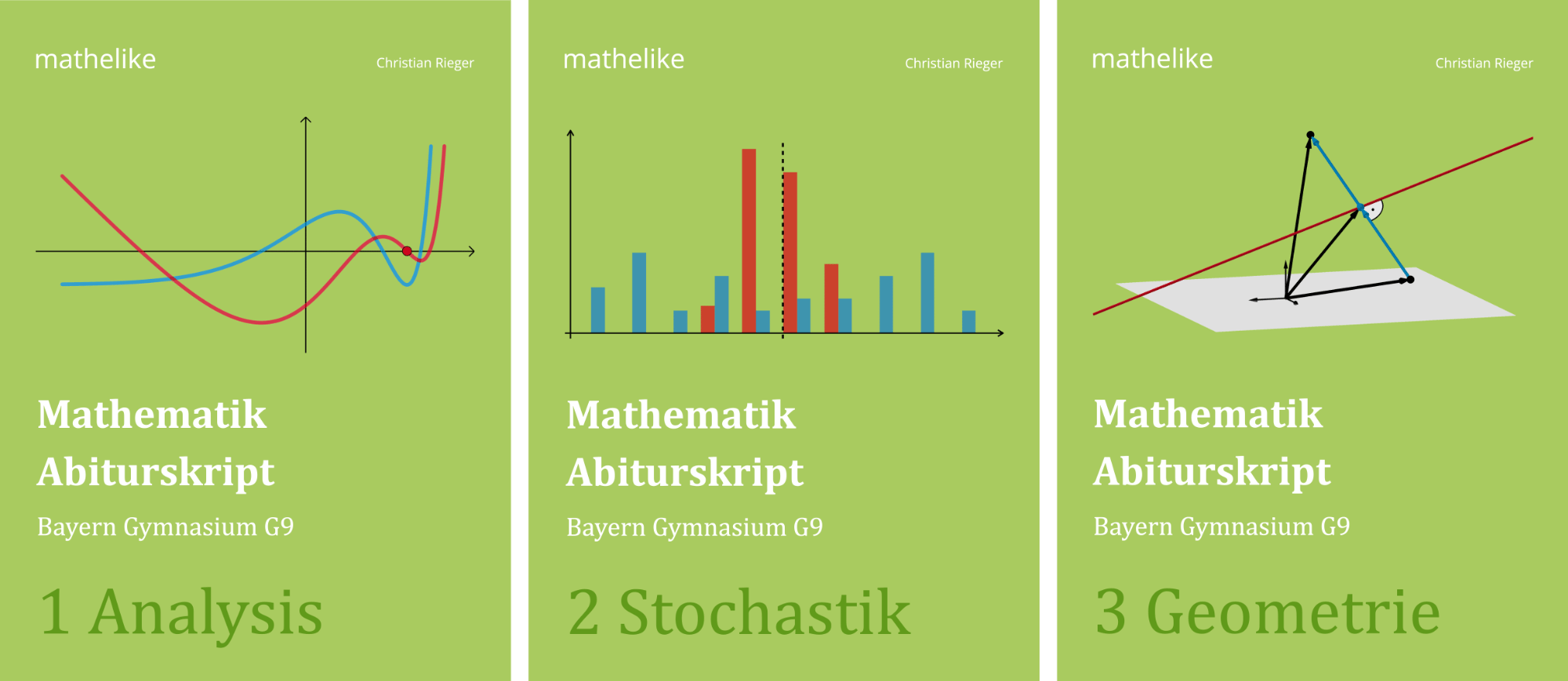Die Strecke \([PQ]\) mit den Eigenschaften \(P(8|-5|1)\) und \(Q\) ist Durchmesser einer Kugel mit Mittelpunkt \(M(5|-1|1)\).
Berechnen Sie die Koordinaten von \(Q\) und weisen Sie nach, dass der Punkt \(R(9|-1|4)\) auf der Kugel liegt.
(3 BE)
Lösung zu Teilaufgabe a
Berechnung der Koordinaten von \(Q\)
![Planskizze: Kugel mit Mittelpunkt M und Durchmesser [PQ]](/images/stories/B2020_PT_A_G1/B2020_PT_A_G1_a.png)
Planskizze: Kugel mit Mittelpunkt \(M\) und Durchmesser \([PQ]\)
Der Ortsvektor \(\overrightarrow{Q}\) des Punktes \(Q\) lässt sich durch Vektoraddition berechnen.
\(P(8|-5|1)\), \(M(5|-1|1)\)
\[\begin{align*} \overrightarrow{Q} &= \overrightarrow{M} + \overrightarrow{MQ} &&| \; \overrightarrow{MQ} = \textcolor{#cc071e}{\overrightarrow{PM}} \\[0.8em] &= \overrightarrow{M} + \textcolor{#cc071e}{\overrightarrow{PM}} \\[0.8em] &= \overrightarrow{M} + (\overrightarrow{M} - \overrightarrow{P}) \\[0.8em] &= \begin{pmatrix} 5 \\ -1 \\ 1 \end{pmatrix} + \left[\begin{pmatrix} 5 \\ -1 \\ 1 \end{pmatrix} - \begin{pmatrix} 8 \\ -5 \\ 1 \end{pmatrix} \right] \\[0.8em] &= \begin{pmatrix} 5 \\ -1 \\ 1 \end{pmatrix} + \begin{pmatrix} -3 \\ 4 \\ 0 \end{pmatrix} \\[0.8em] &= \begin{pmatrix} 2 \\ 3 \\ 1 \end{pmatrix} \end{align*}\]
\[\Longrightarrow \quad Q(2|3|1)\]
oder
\[\begin{align*} \overrightarrow{Q} &= \overrightarrow{P} + 2 \cdot \textcolor{#cc071e}{\overrightarrow{PM}} \\[0.8em] &= \overrightarrow{P} + 2 \cdot (\overrightarrow{M} - \overrightarrow{P}) \\[0.8em] &= \begin{pmatrix} 8 \\ -5 \\ 1 \end{pmatrix} + 2 \cdot \left[ \begin{pmatrix} 5 \\ -1 \\ 1 \end{pmatrix} - \begin{pmatrix} 8 \\ -5 \\ 1 \end{pmatrix} \right] \\[0.8em] &= \begin{pmatrix} 8 \\ -5 \\ 1 \end{pmatrix} + 2 \cdot \begin{pmatrix} -3 \\ 4 \\ 0 \end{pmatrix} \\[0.8em] &= \begin{pmatrix} 8 \\ -5 \\ 1 \end{pmatrix} - \begin{pmatrix} -6 \\ 8 \\ 0 \end{pmatrix} \\[0.8em] &= \begin{pmatrix} 2 \\ 3 \\ 1 \end{pmatrix} \end{align*}\]
\[\Longrightarrow \quad Q(2|3|1)\]
Nachweis, das der Punkt \(R\) auf der Kugel liegt
1. Möglichkeit: Vergleich der Länge des Verbindungsvektors \(\overrightarrow{PM}\) bzw. \(\overrightarrow{QM}\) mit \(\overrightarrow{RM}\)
![Kugel mit Durchmesser [PQ] und Radius [PM]](/images/stories/B2020_PT_A_G1/B2020_PT_A_G1_a3.png)
Da die Strecke \([PQ]\) Durchmesser der Kugel ist, gilt für den Kugelradius \(r\): \(\textcolor{#cc071e}{\overline{PM} = r}\) bzw. \(\textcolor{#cc071e}{\overline{QM} = r}\).
Der Punkt \(R\) liegt auf der Kugel, wenn \(\textcolor{#cc071e}{\overline{RM} = r}\) ist.
\(P(8|-5|1)\), Q\((2|3|1)\), \(M(5|-1|1)\), \(R(9|-1|4)\)
Betrag eines Vektors
\[ \vert \overrightarrow{a} \vert = \sqrt{\overrightarrow{a} \circ \overrightarrow{a}} = \sqrt{{a_1}^2 + {a_2}^2 + {a_3}^2}\]
(vgl. Merkhilfe)
\[\begin{align*} \textcolor{#cc071e}{r} &\textcolor{#cc071e}{=} \textcolor{#cc071e}{\overline{PM}} = \vert \overrightarrow{PM} \vert = \vert \overrightarrow{M} - \overrightarrow{P} \vert \\[0.8em] &= \left| \begin{pmatrix} 5 \\ -1 \\ 1 \end{pmatrix} - \begin{pmatrix} 8 \\ -5 \\ 1 \end{pmatrix} \right| = \left| \begin{pmatrix} -3 \\ 4 \\ 0 \end{pmatrix} \right| \\[0.8em] &= \sqrt{(-3)^{2} + 4^{2} + 0^{2}} = \sqrt{25} = \textcolor{#cc071e}{5} \end{align*}\]
bzw.
\[\begin{align*} \textcolor{#cc071e}{r} &\textcolor{#cc071e}{=} \textcolor{#cc071e}{\overline{QM}} = \vert \overrightarrow{QM} \vert = \vert \overrightarrow{M} - \overrightarrow{Q} \vert \\[0.8em] &= \left| \begin{pmatrix} 5 \\ -1 \\ 1 \end{pmatrix} - \begin{pmatrix} 2 \\ 3 \\ 1 \end{pmatrix} \right| = \left| \begin{pmatrix} 3 \\ -4 \\ 0 \end{pmatrix} \right| \\[0.8em] &= \sqrt{3^{2} + (-4)^{2} + 0^{2}} = \sqrt{25} = \textcolor{#cc071e}{5} \end{align*}\]
\[\begin{align*} \textcolor{#cc071e}{\overline{RM}} &= \vert \overrightarrow{RM} \vert = \vert \overrightarrow{M} - \overrightarrow{R} \vert \\[0.8em] &= \left| \begin{pmatrix} 5 \\ -1 \\ 1 \end{pmatrix} - \begin{pmatrix} 9 \\ -1 \\ 4 \end{pmatrix} \right| = \left| \begin{pmatrix} -4 \\ 0 \\ -3 \end{pmatrix} \right| \\[0.8em] &= \sqrt{(-4)^{2} + 0^{2} + (-3)^{2}} = \sqrt{25} = \textcolor{#cc071e}{5 = r} \end{align*}\]
Also liegt der Punkt \(R(9|-1|4)\) auf der Kugel.
2. Möglichkeit: Punktprobe/Kugelgleichung
Der Nachweis kann auch mittels einer Punktprobe geführt. Hierfür werden die Koordinaten von \(R\) in die Kugelgleichung in Koordinatendarstellung eingesetzt. Ergibt die Gleichung eine wahre Aussage, liegt der Punkt \(R\) auf der Kugel.
Kugelgleichung in Koordinatendarstellung aufstellen:
\(M(\textcolor{#e9b509}{5}|\textcolor{#e9b509}{-1}|\textcolor{#e9b509}{1})\), Kugelradius \(\textcolor{#cc071e}{r}\)
Kugelgleichung
Eine Kugel mit dem Mittelpunkt \(M(m_{1}|m_{2}|m_{3})\) und dem Radius \(r\) wird beschrieben durch:
Vektordarstellung
\[(\overrightarrow{X} - \overrightarrow{M})^{2} = r^{2}\]
Koordinatendarstellung
\[(x_{1} - m_{1})^{2} + (x_{2} - m_{2})^{2} + (x_{3} - m_{3})^{2} = r^{2}\]
\[K \colon (x_{1} - \textcolor{#e9b509}{m_{1}})^{2} + (x_{2} - \textcolor{#e9b509}{m_{2}})^{2} + (x_{3} - \textcolor{#e9b509}{m_{3}})^{2} = \textcolor{#cc071e}{r^{2}}\]
Für die Kugelgleich wird der Radius \(\textcolor{#cc071e}{r}\) benötigt. Dieser ist gleich dem Betrag des Verbindungsvektors \(\textcolor{#cc071e}{\overrightarrow{PM}}\).
\(\overrightarrow{PM} = \begin{pmatrix} -3 \\ 4 \\ 0 \end{pmatrix}\) (vgl. oben)
![Kugel mit Mittelpunkt M und Durchmesser [PQ], Der Radius r ist gleich dem Betrag des Verbindungvektors der Punkte P und M](/images/stories/B2020_PT_A_G1/B2020_PT_A_G1_a2.png)
Betrag eines Vektors
\[ \vert \overrightarrow{a} \vert = \sqrt{\overrightarrow{a} \circ \overrightarrow{a}} = \sqrt{{a_1}^2 + {a_2}^2 + {a_3}^2}\]
(vgl. Merkhilfe)
\[r = \vert \overrightarrow{PM} \vert = \left| \begin{pmatrix} -3 \\ 4 \\ 0 \end{pmatrix} \right| = \sqrt{(-3)^{2} + 4^{2} + 0^{2}} = \sqrt{25} = 5\]
Damit lautet die Kugelgleichung:
\(M(\textcolor{#e9b509}{5}|\textcolor{#e9b509}{-1}|\textcolor{#e9b509}{1})\), \(\textcolor{#cc071e}{r = 5}\)
\[\begin{align*}&K \colon (x_{1} - \textcolor{#e9b509}{5})^{2} + (x_{2} - \textcolor{#e9b509}{(-1)})^{2} + (x_{3} - \textcolor{#e9b509}{1})^{2} = \textcolor{#cc071e}{5^{2}} \\[0.8em] &K \colon (x_{1} - 5)^{2} + (x_{2} + 1)^{2} + (x_{3} - 1)^{2} = 25\end{align*}\]
Punktprobe \(R \in K\) durchführen:
\(R(\textcolor{#e9b509}{9}|\textcolor{#e9b509}{-1}|\textcolor{#e9b509}{4})\)
\[\begin{align*}R \in K \colon (\textcolor{#e9b509}{9} - 5)^{2} + (\textcolor{#e9b509}{-1} + 1)^{2} + (\textcolor{#e9b509}{4} - 1)^{2} &= 25 \\[0.8em] 4^{2} + 0^{2} + 3^{2} &= 25 \\[0.8em] 16 + 9 &= 25 \\[0.8em] 25 &= 25 \quad (\text{w})\end{align*}\]
Also liegt der Punkt \(R(9|-1|4)\) auf der Kugel.


